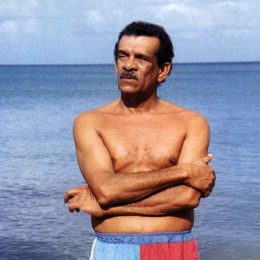At the ripe old age of 40, American industrialist Henry Ford started the Ford Motor Company and made enough money to bathe in by swamping the market with simple, affordable cars. The Model T was the star of his line, but his formula for success was obvious in a turn-of-the-century advertisement for the Fordmobile, cheap at $850: “This new light touring car fills the demand for an automobile between a runabout and a heavy touring car. It is positively the most perfect machine on the market, having overcome all drawbacks such as smell, noise, jolt, etc., common to all other makes of Auto Carriages. It is so simple that a boy of 15 can run it.”
At 39, Trinidad businessman Robert Amar, who inherited an auto assembly and light manufacturing empire employing 700 people almost a decade ago, is doing as Ford did–building simple, low- priced cars which he claims have overcome the drawbacks common to other makes on the Caribbean market.
The Basic Utility Vehicle, the BUV (each letter is pronounced separately), is the car that Amar built along the Ford principles. It’s a tall, compact two-seater buggy with a removable hard top, a rear-wheel-drive that runs on a 1,300ce engine; it gives 40 miles to a gallon and has a capability of 120 kilometers an hour.
It’s called the Basic Utility Vehicle because it is just that. It’s a no-frills chassis and body package. There’s no stereo, no carpeting, no power steering, no power windows (not even windows), and no air-conditioning — well, as there aren’t any doors either, you could say there is natural air-conditioning.
Amar, a straightforward man who goes to the office in short sleeves and chuckles at the comparison between himself and the great Ford, speaks of the BUV in more sociological than economic terms.
“The reason we built this vehicle is that we were looking long-term,” he says of himself and his team of engineers. “We saw that the economies of the Caribbean islands were tight and would be tightening. In that scenario, there would be a large number of young people who would not be able to own a new vehicle. They would have to buy secondhand or wouldn’t be able to afford any vehicle at all.
“So we had to find a product to satisfy the low-budget people in this market so that they could proudly own a new vehicle too. After all, democracy demands that people should be comfortable in their domain.”
Robert Amar set his engineers the task of designing the vehicle on computer three years ago – something that had never been done before in the Caribbean, the company claims. He is projecting sales of US$25 million in the Caribbean over the next five years.
The vehicle will cost US$8,000 in all the islands. So, in a region where non-luxury cars start at roughly US$15,000, Amar is on track with the first Ford principle – make it affordable.
The BUV is not Model T, however. It’s not meant to he a universal car. It is intended primarily for young people (young by Amar’s definition is between 18 and 39) buying their first car, and for auto rental companies catering for tourists. He aims to produce at least 500 a year over the next five years. That’s all the low-budget market in the islands can absorb, he says.
This, Amar claims, is the only vehicle that deserves to be called a Caribbean car.
“The BUV has a fibreglass body. One of the biggest problems with car bodies in the Caribbean is that they tend to corrode. That’s bad for us because we live on small islands where the salty air inevitably encourages corrosion. To guard against that problem we came up with a car body that would not rust.
“The car is open so you can enjoy the tropical climate, but you can close it up for the rain. And it’s high off the ground. We thought it was important to get it high off the ground so that while other people would be shutting down in floods, the BUV driver would be sailing along – not: literally, of course.”
The rugged-looking BUV, which some are already calling “the Love BUV” (as in Love Bug), will stand out among the sleek Japanese and American cars already on Caribbean roads. Amar believes his target market will go for the BUV because it is what they need, just as Ford’s Model T served a rather different, family market.
He is also ruthlessly practical about the BUV’s prospects. “I believe what young men are looking for is something to take them from point A to point B and which can carry around at least one female, and the BUV is just that.”


















